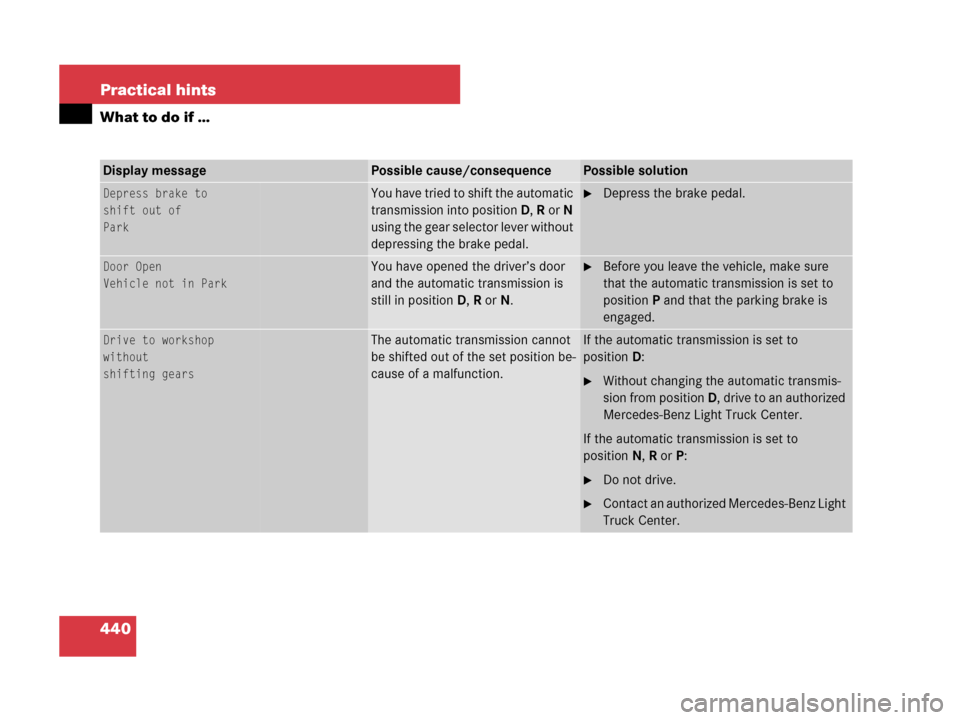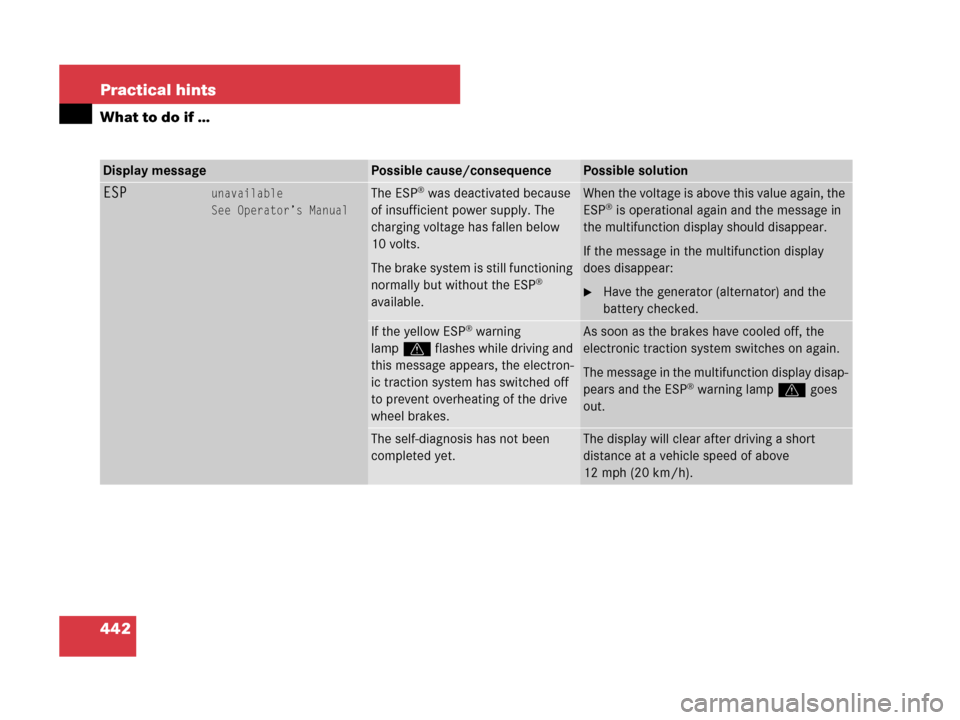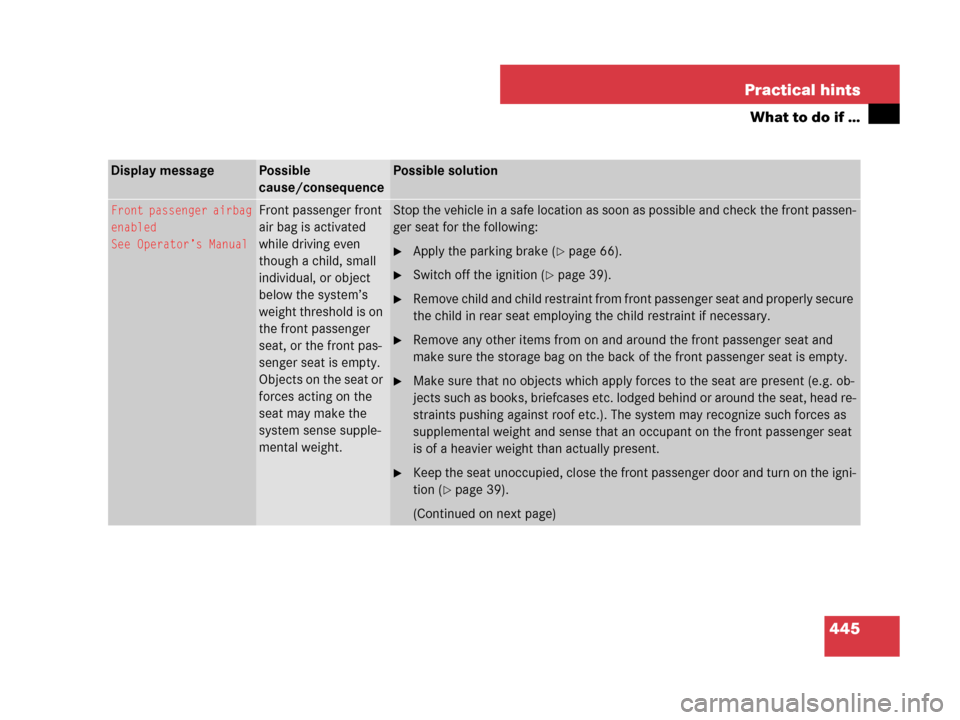Page 424 of 570

423 Practical hints
What to do if …
ProblemPossible cause/conse-
quenceSuggested solution
?(USA only)
±(Canada only)
The yellow engine malfunction
indicator lamp comes on while
driving.There is a malfunction in:
�The fuel management
system
�The ignition system
�The emission control
system
�Systems which affect
emissions
Such malfunctions may result
in excessive emissions values
and may switch the engine to
its limp-home (emergency
operation) mode.
�Have the vehicle checked as soon as
possible by an authorized
Mercedes-Benz Light Truck Center.
An on-board diagnostic connector is
used by the service station to link the
vehicle to the shop diagnostics
system. It allows the accurate identifi-
cation of system malfunctions through
the readout of diagnostic trouble
codes. It is located in the front left area
of the footwell next to the parking
brake pedal.
iSome states may by law require you to visit
a workshop immediately as soon as the engine
malfunction indicator lamp comes on. Check
local requirements.
Page 436 of 570

435 Practical hints
What to do if …
Text messages
Display messagePossible cause/consequencePossible solution
ABSinoperative
See Operator's ManualThe ABS has detected a malfunction
and has switched off.
The ESP
® and the BAS are also
deactivated.
The brake system is still functioning
normally but without the ABS avail-
able.
�Continue driving with added caution.
Wheels may lock during hard braking,
reducing steering capability.
�Have the system checked at an authorized
Mercedes-Benz Light Truck Center as soon
as possible.
Failure to follow these instructions increases
the risk of an accident.
unavailable
See Operator’s ManualThe ABS was deactivated because of
insufficient power supply. The charg-
ing voltage has fallen below 10 volts.
The brake system is still functioning
normally but without the ABS
available.When the voltage is above this value again, the
ABS is operational again and the message in
the multifunction display should disappear.
If the message in the multifunction display
does not disappear:
�Have the generator (alternator) and the
battery checked.
Page 437 of 570

436 Practical hints
What to do if …
Display messagePossible cause/consequencePossible solution
ABSunavailable
See Operator’s ManualIf the yellow ESP® warning
lampv flashes while driving and
this message appears, the electron-
ic traction system has switched off
to prevent overheating of the drive
wheel brakes.As soon as the brakes have cooled off, the
electronic traction system switches on again.
The message in the multifunction display disap-
pears and the ESP
® warning lampv goes
out.
The self-diagnosis has not yet been
completed yet.The display will clear after driving a short
distance at a vehicle speed of above
12 mph (20 km/h).
Cruise
control and
SPEEDTRONIC
inoperativeThe cruise control is malfunctioning.�Have cruise control checked by an
authorized Mercedes-Benz Light Truck
Center.
Cruise
control––– mphYou have attempted to set a
speed while driving below
20 mph (30 km/h).�Accelerate to a speed exceeding
20 mph (30 km/h) and set the speed
(
�page 266).
The ESP® is switched off.�Switch on the ESP® (�page 105).
The automatic transmission is set to
position P, R, or N.�Set the automatic transmission to
positionD (
�page 197).
The vehicle is secured with the
parking brake.�Release the parking brake (�page 57).
Page 438 of 570
437 Practical hints
What to do if …
Display messagePossible cause/consequencePossible solution
DISTRONIC––– mphYou have attempted to set a
speed while driving below
20 mph (30 km/h).�Accelerate to a speed exceeding
20 mph (30 km/h) and set the speed
(
�page 266).
The ESP® is switched off.�Switch on the ESP® (�page 105).
The automatic transmission is set to
position P, R, or N.�Set the automatic transmission to posi-
tion D (
�page 197).
The vehicle is secured with the
parking brake.�Release the parking brake (�page 57).
inoperativeThe Distronic* or the Distronic*
display are malfunctioning.�Have the system checked by an
authorized Mercedes-Benz Light Truck
Center.
OverrideYou have accelerated. The
Distronic* has switched off.�Stop accelerating.
Page 441 of 570

440 Practical hints
What to do if …
Display messagePossible cause/consequencePossible solution
Depress brake to
shift out of
ParkYou have tried to shift the automatic
transmission into position D, R or N
using the gear selector lever without
depressing the brake pedal.�Depress the brake pedal.
Door Open
Vehicle not in ParkYou have opened the driver’s door
and the automatic transmission is
still in position D, R or N.�Before you leave the vehicle, make sure
that the automatic transmission is set to
position P and that the parking brake is
engaged.
Drive to workshop
without
shifting gearsThe automatic transmission cannot
be shifted out of the set position be-
cause of a malfunction.If the automatic transmission is set to
positionD:
�Without changing the automatic transmis-
sion from position D, drive to an authorized
Mercedes-Benz Light Truck Center.
If the automatic transmission is set to
positionN, R or P:
�Do not drive.
�Contact an authorized Mercedes-Benz Light
Truck Center.
Page 443 of 570

442 Practical hints
What to do if …
Display messagePossible cause/consequencePossible solution
ESPunavailable
See Operator’s ManualThe ESP® was deactivated because
of insufficient power supply. The
charging voltage has fallen below
10 volts.
The brake system is still functioning
normally but without the ESP
®
available.
When the voltage is above this value again, the
ESP® is operational again and the message in
the multifunction display should disappear.
If the message in the multifunction display
does disappear:
�Have the generator (alternator) and the
battery checked.
If the yellow ESP® warning
lampv flashes while driving and
this message appears, the electron-
ic traction system has switched off
to prevent overheating of the drive
wheel brakes.As soon as the brakes have cooled off, the
electronic traction system switches on again.
The message in the multifunction display disap-
pears and the ESP
® warning lampv goes
out.
The self-diagnosis has not been
completed yet.The display will clear after driving a short
distance at a vehicle speed of above
12 mph (20 km/h).
Page 444 of 570
443 Practical hints
What to do if …
Display messagePossible cause/consequencePossible solution
PShift to PYou have started the engine or
switched on the ignition with
KEYLESS-GO* and opened the
driver’s door with the automatic
transmission not set to positionP.�Set the automatic transmission to
positionP.
or
�Close the driver’s door
Shift to P or N
to start engineYou have attempted to start the
engine with the KEYLESS-GO*
start/stop button while the auto-
matic transmission was set to
positionR orD.�Set the automatic transmission to
positionP orN.
Make sure the brake pedal is depressed
when attempting to start the engine with
the KEYLESS-GO* start/stop button.
Only shift to
Park when vehicle
is stationaryYou have tried to shift the transmis-
sion into position P using the gear
selector lever although the vehicle is
still in motion.�Stop the vehicle.
Page 446 of 570

445 Practical hints
What to do if …
Display messagePossible
cause/consequencePossible solution
Front passenger airbag
enabled
See Operator’s ManualFront passenger front
air bag is activated
while driving even
though a child, small
individual, or object
below the system’s
weight threshold is on
the front passenger
seat, or the front pas-
senger seat is empty.
Objects on the seat or
forces acting on the
seat may make the
system sense supple-
mental weight.Stop the vehicle in a safe location as soon as possible and check the front passen-
ger seat for the following:
�Apply the parking brake (�page 66).
�Switch off the ignition (�page 39).
�Remove child and child restraint from front passenger seat and properly secure
the child in rear seat employing the child restraint if necessary.
�Remove any other items from on and around the front passenger seat and
make sure the storage bag on the back of the front passenger seat is empty.
�Make sure that no objects which apply forces to the seat are present (e.g. ob-
jects such as books, briefcases etc. lodged behind or around the seat, head re-
straints pushing against roof etc.). The system may recognize such forces as
supplemental weight and sense that an occupant on the front passenger seat
is of a heavier weight than actually present.
�Keep the seat unoccupied, close the front passenger door and turn on the igni-
tion (
�page 39).
(Continued on next page)